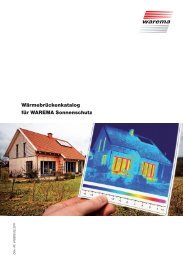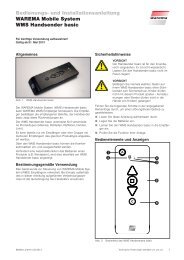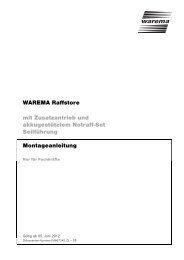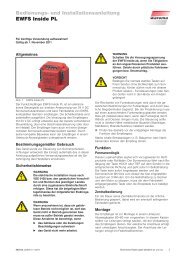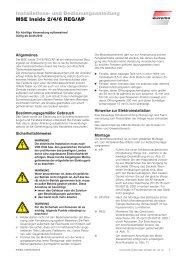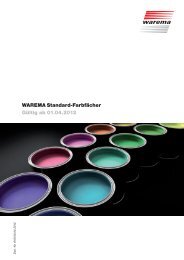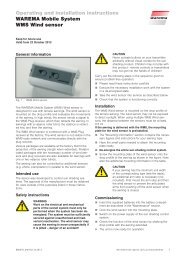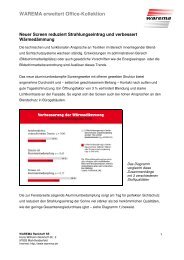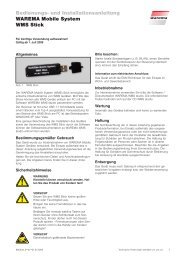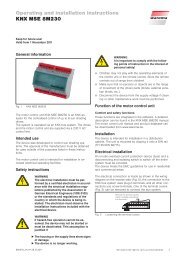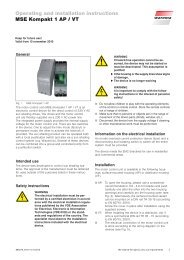WAREMA Mobile System® WMS Central transmitter
WAREMA Mobile System® WMS Central transmitter
WAREMA Mobile System® WMS Central transmitter
You also want an ePaper? Increase the reach of your titles
YUMPU automatically turns print PDFs into web optimized ePapers that Google loves.
Introduction<strong>WAREMA</strong><strong>WMS</strong> <strong>Central</strong> <strong>transmitter</strong>4.4 Definitions4.4.1 Transmitter and receiver4.4.2 Learn mode4.4.3 Channels and products4.4.4 ScenesBefore you commission the <strong>WMS</strong> products, this chapter explains variousterms to familiarise you with the many options and the project concept.The <strong>WAREMA</strong> <strong>Mobile</strong> System is based on a bidirectional data exchange.This means that every component is both a <strong>transmitter</strong> and a receiver. Forevery piece of information sent, a response is received from the counterpart.However, because some devices primarily send commands and information,and other devices receive these, their categorisation into <strong>transmitter</strong>s andreceivers provides clarity.Hand-held <strong>transmitter</strong>s and <strong>Central</strong> <strong>transmitter</strong>s are one type of <strong>transmitter</strong>;they are used to initiate control commands, start learning operations andchange parameters.Weather stations and sensors are another type of <strong>transmitter</strong>; these regularlytransmit information to the receivers and can thus automatically activate controlcommands.Receivers are either integrated in a sun shading product or are connectedupstream from a sun shading product, a lighting, heating or air conditioningunit, or a window. The receiver receives the switch commands from the <strong>transmitter</strong>and then executes the corresponding move or switch commands.When the receiver is delivered, it does not "know" any <strong>transmitter</strong>s initiallyand first needs to learn to which <strong>transmitter</strong>s it should respond. We refer tothis process as "learning".The transmitting device (the <strong>transmitter</strong>) has channels that receivers can belearned into. For each channel, the information is simultaneously sent to allreceivers learned into that channel. Up to 10 receivers and 4 sensors can belearned into each channel.The <strong>WMS</strong> <strong>Central</strong> <strong>transmitter</strong> can administer up to 96 channels. Each channelcan access either a single product (e.g. an awning) or several productsof the same type (e.g. roller shutters).The term "product" is identical in meaning to the term "actuator" in the <strong>WMS</strong>.For each product, an actuator (e.g. <strong>WMS</strong> Plug receiver) is required to controlthe drive motors of the product, for example.When a receiver is learned into a channel, the product type must be specified.The product type determines which settings and control options areavailable for that receiver.A scenario (e.g. "roller shutters up, lights off, heating off" when leaving theflat) can be stored ("learned") in a scene and be called up again at a latertime.For this, one or more channels are associated with the scene and the positionsand switching states are set as desired. After the scene is stored,this scenario can be recalled at any time by selecting the scene. Up to 32scenes can be created in the central <strong>transmitter</strong>.22We reserve the right to carry out improvements890405_0•en•01.11.2009





